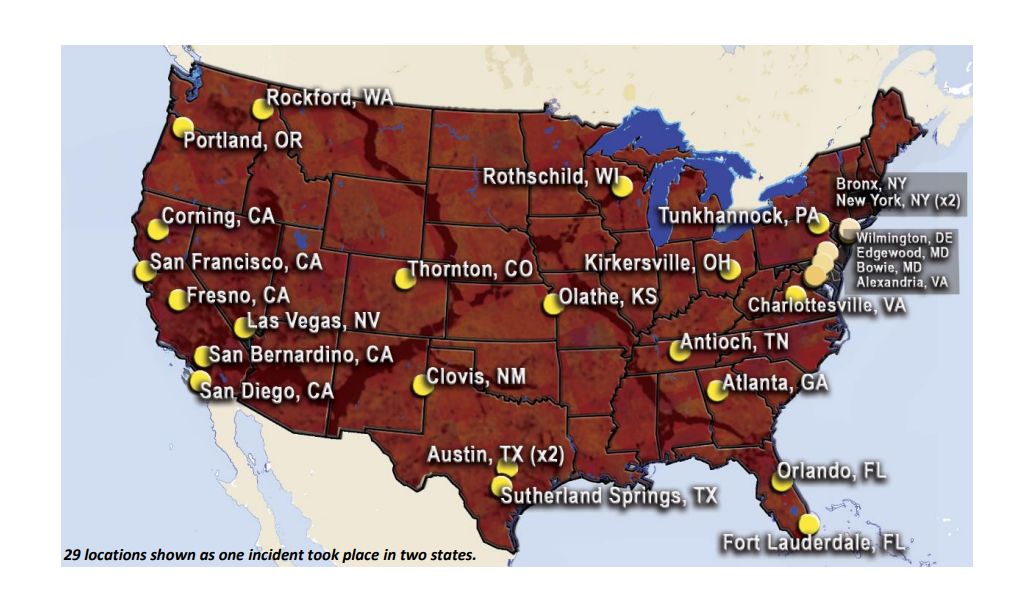New Mass Attack Research Stirs Controversy Among Threat Assessment Professionals
Campus officials conducting threat assessments should appreciate the value of the U.S. Secret Service’s new research but not rely on it as the sole source of reasoning for their conclusions.

"Mass Attacks in Public Spaces - 2017" was published by the U.S. Secret Service in March and reviewed 28 incidents of mass attacks, during which three or more persons were harmed and were carried out in public places within the United States last year.
In March, the U.S. Secret Service came out with a study it conducted on all 28 of the mass attacks in public spaces (where three or more were harmed) that occurred in the United States in 2017. Most of the attacks (82 percent) were carried out with firearms, while 11 percent used vehicles and seven percent used knives.
The Secret Service was wise to mention in the first paragraph that this study was “…to identify key themes for enhancing threat assessment and investigative practices.” Additionally, it stated that “Regardless of whether these attacks were acts of workplace violence, domestic violence, school based violence or terrorism, similar themes were observed in the backgrounds of the perpetrators.” Those themes included:
- Nearly half were motivated by a personal grievance related to a workplace, domestic, or other issue.
- Over half had histories of criminal charges, mental health symptoms, and/or illicit substance use or abuse.
- All had at least one significant stressor within the last five years, and over half had indications of financial instability in that timeframe.
- Over three-quarters made concerning communications and/or elicited concern from others prior to carrying out their attacks. On average, those who did elicit concern caused more harm than those who did not.
The study was met with some cautionary pushback from many clinicians. One well respected threat assessment pioneer summed-up what most were saying. The study “…has value but there was no control or comparison group. Therefore, none of the variables can be used by threat assessors as predictors or even correlates of risk.” Honestly, it’s hard to really argue his point. But like my mother always said, don’t go throwing the baby out with the bath water.
We are all trying to determine how to best decide the risk potential for violence of an individual in order to prevent harm befalling anyone…including the person of interest (POI). In most universities and schools these days, some form of threat management team — sometimes referred to as the Behavioral Intervention Team — is tasked with making this determination and then developing the best plan possible to handle the situation. We all know that the decisions are made by well-educated and experienced individuals, but threat assessing is still not an exact science.
However, studies like the recent Secret Service one are invaluable to bring pieces of the puzzle to bear when considering the risk potentials. When I was collecting my hours to become a licensed psychologist, I worked in an oncology clinic for many years and discovered a remarkable theme. I could point to a major stressor or a series of minor stressors that occurred in every cancer patient I saw six-18 months prior to them getting cancer. However, I would never even think to suggest that because you have had a major stressor in the last few months, you are going to get cancer!
Let’s applaud the Secret Service study for its intentions “to identify key themes for enhancing threat assessment and investigative practices.” It is one piece of the puzzle that can greatly assist anyone assessing a risk level — and there are so many more. I believe the critical factor is making sure an assessor (or the team doing this work) makes sure they have all the information they need before making a decision. Jumping to conclusions before such data is obtained and evaluated is not only foolish, it could be life threatening.
Now we all know that sometimes you just cannot get to the information you need for a variety of reasons. That’s why having a team approach to this system is so invaluable. Bringing together folks from a wide variety of backgrounds and expertise — not threat assessment experts (although having one you can consult on speed dial is a good idea) — provides the best opportunity to develop an educated deduction in all of these sensitive and often convoluted situations.
So read studies like this carefully, soak up the information, refer to it when discussing your opinions, but DO NOT rely on it as the sole source reasoning for your conclusion. You must do your due diligence regarding the POI (background, past behavioral history, etc.), as well as the potential victim (if any). You must look at the environment (not only the POI’s familiarity, but victim availability, attitudes towards negative actions, etc.). You must interview all those who may provide valuable information — but never more than needed.
This last part can be tricky — interviews…especially of the POI. If there is no other way of getting the information you need, then you may have to interview the POI. I know almost all human resource, mental health professionals and attorneys feel it is important to interview the POI in order to allow them to tell you their side of the story, but is it worth saying something to them that may actually become a triggering event?
There is a lot left to learn about threat assessments. Review everything you can get your hands on as I do daily; discuss/argue about it with your colleagues; consult with experts when there are questions; but don’t assume any research cannot be part of the consideration equation.
Michael H. Corcoran, Ph.D., is president of the Workthreat Group, LLC. Dr. Corcoran was in law enforcement for over 34 years and has been in the threat assessment field since 1970 when he entered the U.S. Secret Service. A founding member of ATAP, Dr. Corcoran serves Fortune 500 companies, medical and mental health facilities, school districts and universities around the country. He also served as president of Henley-Putnam University from 2002-2011.
Photo: DHS, U.S. Secret Service Mass Attacks in Public Spaces – 2017
If you appreciated this article and want to receive more valuable industry content like this, click here to sign up for our FREE digital newsletters!
 Leading in Turbulent Times: Effective Campus Public Safety Leadership for the 21st Century
Leading in Turbulent Times: Effective Campus Public Safety Leadership for the 21st Century
This new webcast will discuss how campus public safety leaders can effectively incorporate Clery Act, Title IX, customer service, “helicopter” parents, emergency notification, town-gown relationships, brand management, Greek Life, student recruitment, faculty, and more into their roles and develop the necessary skills to successfully lead their departments. Register today to attend this free webcast!







